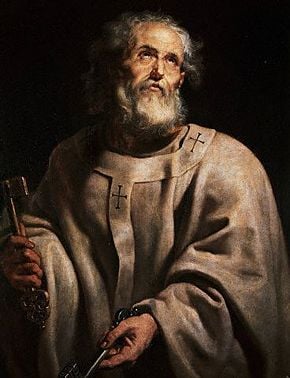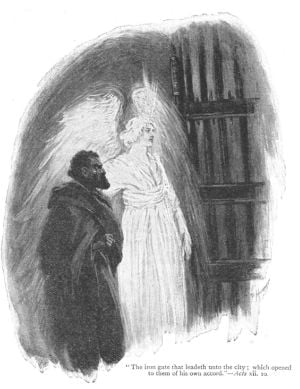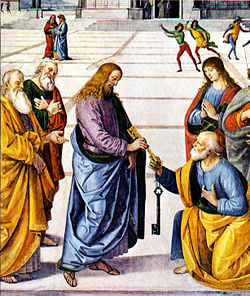Saint Peter
| Saint Peter | |
|---|---|
Saint Peter, by Peter Paul Rubens | |
| Born | Unknown |
| Died | ~64 |
| Major shrine | Saint Peter's Basilica, Rome |
| Feast | February 22, June 29, November 18 |
| Attributes | man crucified head downwards |
| Patronage | See St. Peter's Patronage |
| Controversy | Controversy exists as to whether Peter was truly a pope, and the veracity of the many miracles attributed to him |
The Apostle Peter, also known as Saint Peter, and Cephas—original name Simeon son of Jonah—was one of the Twelve Apostles of Jesus. His life is prominently featured in the New Testament Gospels and the Acts of the Apostles.
Peter was a Galilean fisherman assigned a leadership role by Jesus, who reportedly gave him the keys of heaven and called him the "rock" on whom the church would be built. Although later failing in his discipleship at several crucial moments during Jesus' lifetime, Peter went on to became an effective leader of the early church. Thousands were converted by his sermons, and many miracles were attributed to him. His relations with Saint Paul, however, were stormy, as the two leaders disagreed about fellowship between Jewish and Gentile Christans.
In Catholic tradition, Peter was the first pope. The ancient Christian churches all consider him a major saint and associate him with the foundation of the church in Rome, but differ about the authority the Roman patriarch in present-day Christianity. A large body of literature was attributed to Peter after his death, including two letters included in the New Testament.
Tradition holds that the Roman authorities sentenced Peter to death by crucifixion. According to a story recorded in the apocryphal Acts of Peter, he was crucified head down. The Roman Martyrology assigns June 29 as the feast day of both Peter and Paul. Tradition locates his burial place where the Basilica of Saint Peter was later built, directly beneath the Basilica's high altar.
Jesus' chief disciple
The New Testament portrays Peter as Jesus' chief disciple, a man of simple faith who was far from perfect in his discipleship but could be trusted in the long run as a "rock" upon whom the later church could stand.
According to the Gospel of John, Peter was born in Bethsaida (John 1:44). His father's name is given as Jonah Matthew 16:17). Each of the synoptic gospels recounts how Peter's mother-in-law was healed by Jesus at their home in Capernaum (Matthew 8:14–17), implying that Peter was married. Saint Paul likewise mentions Peter having a wife, who accompanied him on his missionary journeys (1 Corinthians 9:5).
Before becoming a disciple of Jesus, Peter, then called Simon, was a fisherman along with his brother Andrew. The Gospel of John also depicts Peter fishing, but only after the resurrection.
Calling by Jesus
Matthew and Mark report that while fishing in the Lake of Gennesaret (Galilee), Simon and his brother Andrew were called by Jesus, with no previous contact, to be his followers, with the words, "Follow me, and I will make you fishers of men" (Matthew 4:18–19; Mark 1:16–17). In Luke's account, Simon is the owner of a boat that Jesus uses to preach to the multitudes who were pressing on him at the shore of Lake Gennesaret (Luke 5:3). Jesus then amazes Simon and his companions, James and John, by telling them to lower their nets, whereupon they catch a huge number of fish. Immediately after this, they follow him.
The account of the Gospel of John, however, has Peter meeting Jesus for the first time by the Jordan river, where Peter was a disciple of John the Baptist (John 1:35–42). Andrew, we are told, heard John the Baptist describe Jesus as the "Lamb of God," whereupon he followed Jesus. He then went and fetched his brother Simon, saying, "We have found the Messiah," and brought him to Jesus. Jesus then gave Simon the name Cephas, meaning "rock," in Aramaic. Peter (Petrus) is simply a Greek translation of "Cephas."
Position among the apostles
Peter is also often depicted as spokesman of all the apostles, and as one to whom Jesus gave special authority. According to the Gospel of Matthew, Peter alone was able to walk on water after seeing Jesus do the same thing (Matthew 14:22–32). The gospels of Mark and John also mention Jesus walking on water, but do not mention Peter doing so.
It is Peter who first declares Jesus the Messiah in the synoptic gospels, saying "You are the Christ, the Son of the living God." (Matthew 16:16) Jesus praises Peter for this confession and declares, punning on Peter's nickname: "I tell you that you are Peter, and on this rock I will build my church, and the gates of Hades will not overcome it." (Matthew 16:18)
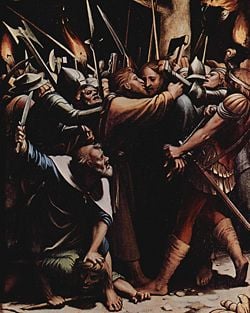
Peter is frequently mentioned in the Gospels as forming, together with James the Elder and John, a special group, or trinity of disciples, within the Twelve Apostles. This core group of three was present at special incidents, such as the transfiguration and Jesus' prayer in Gethsemane, in which the others did not participate. Mark 5 reports that Peter alone was allowed to follow Jesus into the house of the synagogue leader Jairus where Jesus brought Jairus' daughter back from the dead. Several times, Jesus takes Peter, John, and James aside and reveals things to them that the other disciples do not hear (e.g. Mark 13).
Peter's failures
Peter remonstrated with Jesus after Jesus revealed the possibility that he would suffer death at Jerusalem, prompting Jesus to declare: "Get behind me, Satan! You do not have in mind the things of God, but the things of men." (Mark 8:33)
All four canonical gospels recount that, during the Last Supper, Jesus prophetically foretold that Peter would deny association with him three times that same night. In Matthew, Peter insisted, "Even if I have to die with you, I will never disown you." (Matthew 26:35) In Mark 14:29 he declared, "Even if all fall away, I will not."
Luke reports that, after the Last Supper, Jesus instructed the disciples to bring two swords with them to Gethsemane (Luke 22:38), where he commanded Peter and the other two chief disciples to keep watch while he prayed in a garden. Upon returning to find the men slumbering, Jesus addressed Peter to say, "Watch and pray so that you will not fall into temptation. The spirit is willing, but the body is weak." (Matthew 26:41) While Peter slept again, God refused Jesus' plea to "let this cup pass" (Matthew 26:39). Meanwhile, Judas Iscariot was able to approach unhindered and betray Jesus to the guards who sought to arrest him.
According to John, Peter then cut off the ear of a servant of the high priest.(John 18:10) The synoptic gospels also mention this incident, but do not identify Peter as the swordsman. Jesus rebuked this act of violence, which had come to late to protect Jesus in any event. Luke adds the detail that Jesus touched the guard's ear and healed it.
Peter joined the other disciples in fleeing after Jesus' arrest. He denied his association with Jesus three times, and did not dare to witness his execution.
Resurrection appearances
In John's gospel, Peter is the first person to enter the empty tomb, although the women and the beloved disciple get there before him (John 20:1–9). In Luke's account, the women's report of the empty tomb is dismissed by the apostles and Peter goes to check for himself (Luke 24:1–12).
Paul's First Epistle to the Corinthians contains a list of resurrection appearances of Jesus, the first of which is an appearance to "Cephas" (1 Corithians 15:3–7). An appearance to "Simon" is also reported in Luke 24:34. In the final chapter of the Gospel of John, Peter three times affirms his love for Jesus, apparently restoring his threefold denial, and Jesus reconfirms Peter's position (John 21:15–17), instructing him to "feed my sheep."
Peter in the early church
The author of the Acts of the Apostles portrays Peter as an extremely important figure within the early Christian community, although it is not clear whether Peter or James, "the Lord's brother," is the leading figure in the Jerusalem church. Peter did play the key role early on. He took the lead in selecting a replacement for Judas Iscariot (Acts 1:15) and delivered a significant speech during Pentecost at which 3,000 Jews reportedly accepted his message and were baptized (Acts 2:38-41). He became famous in Jerusalem for healing a crippled beggar (Acts 3). He was twice arraigned before the Sanhedrin for preaching the gospel (Acts 4:7–22), (Acts 5:18–42). It was also Peter who condemned the disciple Annanias for withholding from the church part of the proceeds of the sale of his home, after which the Holy Spirit immediately killed both Annanias and his wife (Acts 5:1-10).
Peter came to Samaria after the gospel began to spread there, and it was he who harshly scolded the new convert Simon Magus for offering money to obtain the ability to impart the Holy Spirit to other believers (Acts 8). Peter undertook a missionary journey to Lydda, Joppa, and Caesarea (Acts 9:32–10:2), becoming instrumental in the decision to evangelize the Gentiles (Acts 10). He also famously brought about the resurrection of the child Tabitha (Acts 9:40). In Acts 11, Peter was criticized by the Jerusalem church for associating too closely with Gentiles but insisted that he has been commanded to do so by God in a dream. Acts 12 relates how Peter miraculously escaped from prison after having been arrested by Herod Agrippa I.
Peter was present at the Council of Jerusalem (Acts 15), where Paul argued the case for accepting Gentiles into the Christian community without circumcision. At this point, it is no longer Peter, but James who is the deciding authority and sends a letter to the Gentile churches informing them of his ruling. Acts turns its attention to Paul's ministry at this point in its narrative, and we must therefore turn to Paul for further information.
From Paul, we learn that Peter seems to have resided for some time at Antioch. We also learn from Paul that Peter's wife is allowed to accompany him on his journeys, with financial support provided by the churches (1 Corinthians 9:4-6).
Peter's relationship with Paul was not always amicable. Paul relates an incident in the Epistle to the Galatians (Galatians 2:11), in which he publicly confronted Peter for hypocrisy in refusing to dine at the same table with Gentile Christians after certain "men from James" arrived at the city. Other letters of Paul contain numerous references to disagreements between himself and other disciples on how the Jewish law relates to Gentile Christians. One of the factions of the Corinthian church claims to follow "Cephas," while another follows Paul, and a third adheres to Apollos (1 Corinthians 1:12).
Outside the New Testament
Various sayings and acts are attributed to Peter in the New Testament Apocrypha, all of which are considered by most scholars to originate from a period later than the synoptic gospels, and usually from the second century C.E. While some of these traditions have come to be accepted by orthodox traditions, others are considered legendary, and some are rejected as heretical.
Sayings and Acts of Peter
Two sayings are attributed to Peter in the Gospel of Thomas. In the first, Peter compares Jesus to a "just messenger."[1] In the second, Peter asks Jesus to "make Mary leave us, for females don't deserve life." [2] Jesus denies his request, saying that he will guide her to become "male." In the Apocalypse of Peter, Peter holds a dialog with Jesus about the parable of the fig tree and the fate of sinners.[3]
In the Gospel of Mary, Peter appears to be jealous of Mary (probably Mary Magdalene). He says to the other disciples, "Did he (Jesus) really speak privately with a woman and not openly to us? Are we to turn about and all listen to her? Did He prefer her to us?"[4] In reply to this, Levi says "Peter, you have always been hot tempered." [5]
Other non-canonical texts that attribute sayings to Peter include the Secret Book of James, 2 Clement, and the Acts of Peter. The fragmentary Gospel of Peter contains an account of the death of Jesus differing significantly from the canonical gospels. It gives little information about Peter himself, except that after the discovery of the empty tomb, "I, Simon Peter, and Andrew my brother, took our fishing nets and went to the sea." [6]
Many miracles are attributed to Peter in the Acts of Peter and other apocryphal works. In the Acts of Peter, Peter holds a miracle contest with Simon Magus, outdoing him at every turn. In the Acts of Peter and Andrew he literally pulls a camel through the eye of a needle. In the Apocalypse of Peter, he reveals the cataclysmic events of the Last Days.
Late legends said that Peter had a daughter, who was sometimes identified with the virgin martyr Petronilla.[7]
Peter's death
Tradition holds that Peter met martyrdom in Rome, probably at the time of the great fire of the year 64, for which the Emperor Nero blamed the Christians.
Clement of Rome, in his Letter to the Corinthians (Chapter 5), written c. 80-98, speaks of Peter's martyrdom in the following terms: "Through jealousy and envy the greatest and most just pillars of the Church were persecuted, and came even unto death… Peter, through unjust envy, endured not one or two but many labors, and at last, having delivered his testimony, departed unto the place of glory due to him."
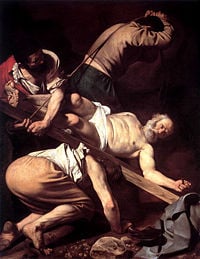
Dionysius of Corinth wrote: "Both of them (Peter and Paul) alike planted in our Corinth and taught us; and both alike, teaching similarly in Italy, suffered martyrdom at the same time" (Letter to Pope Soter [170 C.E.], in Eusebius, History of the Church 2:25:8).
The apocryphal Acts of Peter, relates that the Romans crucified Peter upside down at his request, due to his wishing not to be equated with Jesus. The Acts of Peter is also thought to be the source for the tradition about the famous phrase Quo Vadis—Where are you going? According to this tradition, Peter was fleeing Rome to avoid execution when he saw a vision of Jesus and asked him where he was going, to which Jesus responded that he was "going to Rome, to be crucified again." This caused Peter to decide to return to the city and accept martyrdom.
In the fourth century, when the Emperor Constantine I decided to honor Peter with a large basilica, the precise location of Peter's burial was already firmly fixed in the belief of the Christians of Rome. The building was thus erected on a site that involved considerable difficulties. The focal point of Saint Peter's Basilica, both in its original form and in its later complete reconstruction, is the altar placed over what is held to be the exact place where Peter was buried. Recently, however, these traditional views concerning Peter's death have come into question, because of a 1953 excavation of what some believe to be Peter's Tomb in Jerusalem.[8]
The traditional feast days of Saint Peter are:
- January 18, Feast of the Chair of St. Peter at Rome
- March 19, Feast of the Chair of St. Peter at Antioch
- June 29, Feast of Saints Peter and Paul
- August 1, St. Peter in Chains
- November 18, Feast of the Dedication of the Basilicas of Saints Peter and Paul
Peter's primacy
The question of Peter's primacy over the other apostles, and the primacy of Rome over other the churches of cities, is much debated. The gospels clearly portray Jesus as conferring a special status on Peter, but he does not exercise authority over them until after the resurrection. Indeed, he is seen failing to understand Jesus' intent (Matthew 16:23), falling asleep on watch at a crucial moment, and even denying his association with Jesus in order to save his own life. After the resurrection, Peter plays a key role in the Jerusalem church at first, but later it is James the Just who appears to be in charge, and Peter and Paul are seen at odds at Antioch. Peter plays no role in the second half of the Book of Acts, and his association with Rome is found nowhere in the New Testament.
However, by the late second century C.E., the tradition that Peter and Paul were united in martyrdom at Rome was well established. Soon, the "See of Peter" emerged as a center of orthodox authority, though not the only one.
Irenaeus of Lyon (late second century) wrote in Against Heresies that the church of Rome was the seat of apostolic authority, referring to:
the succession of the bishops of the greatest and most ancient church known to all, founded and organized at Rome by the two most glorious apostles, Peter and Paul... With that church, because of its superior origin, all the churches must agree, that is, all the faithful in the whole world, and it is in her that the faithful everywhere have maintained the apostolic tradition. (Book III, Chapter III, paragraphs 2–3)
Tertullian of Carthage added: "If you are near Italy, you have Rome, where authority is at hand for us too. What a happy church that is, on which the apostles poured out their whole doctrine with their blood; where Peter had a passion like that of the Lord, where Paul was crowned with the death of John [the Baptist, by being beheaded]."
Church traditions
In the Roman Catholic Church, Peter's leadership role among the apostles lies at the root of the leadership role of the pope among the bishops of the Church as the body of Christ. Popes wear the Fisherman's Ring, which bears an image of the saint casting his nets from a fishing boat. The keys used as a symbol of the pope's authority refer to the "keys of the kingdom of Heaven" promised to Peter (Matthew 16:18–19). Peter is therefore often depicted in both Western and Eastern Christian art holding a key or a set of keys. The Roman patriarch, though not the only "pope" of the time, was recognized as the successor of Peter as bishop of Rome by all the ancient Christian churches, except those deemed to be heretical.
However, many Protestants the idea of Peter's primacy on the grounds of lack of contemporary evidence, as the tradition that Peter went to Rome and was martyred there was not well established until the second century. Moreover, even if the tradition is true, this does not necessarily establish Rome's authority over other churches. In the Orthodox tradition, the Peter position is seen as primus inter pares—the first among equals, together with the other metropolitan patriarchates.
Recent studies of apocryphal literature, especially of the gnostic variety, indicate that Peter's position was emphasized by the "orthodox" churches as a rallying point to strengthen the authority of the orthodox bishops against supposedly false teachings. Thus, some of the gnostic gospels and other apocryphal literature portray Peter in a more negative light than the canonical gospels and surviving church tradition.
Writings
New Testament
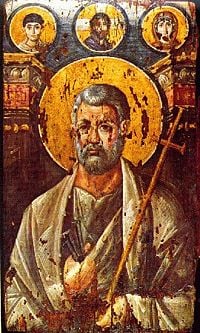
The New Testament includes two letters (epistles) ascribed to Peter. However, the majority of modern scholars do not believe that the letters are genuinely written by Saint Peter.
The textual features of these two epistles indicate that they were not written by the same hand. Moreover, both epistles demonstrate a high quality of cultured and urban Greek, a fact at odds with the linguistic skill expected from an Aramaic-speaking fisherman, who would have learned Greek as a second or third language. Some scholars argue that theological differences imply different sources, and point to the lack of references to 2 Peter among the early Church Fathers. However, the author of the first epistle explicitly states that he is using a secretary, which could account for some of these objections. Of the two epistles, the first epistle is considered the earlier.
Pseudepigrapha and apocrypha
There are also a number of other apocryphal writings that have been either attributed to or written about Saint Peter. They were from antiquity regarded as pseudepigrapha. These include:
- Gospel of Peter, a Docetic narrative that has survived only in part
- Acts of Peter, from which several traditions about Peter have passed into accepted tradition
- A Letter of Peter to Philip, which was preserved in the Nag Hammadi library
- The Apocalypse of Peter, which was considered as genuine by many Christians as late as the fifth century and was a candidate for inclusion in the New Testament
- The Epistula Petri, an introductory letter ascribed to Peter that appears at the beginning of at least one version of the Clementine literature
- The Acts of Peter and Andrew, in which Peter conducts several miracles, most famously causing a camel to pass through the eye of a needle
- The Acts of Peter and the Twelve, an allegory similar to the parable of the Pearl of Great Price, together with a gnostic exposition of the story
- The Acts of Peter and Paul, based partly on a section of the Acts of Peter describing Peter's death, but portraying Peter and Paul united in martyrdom at Rome.
Patronage
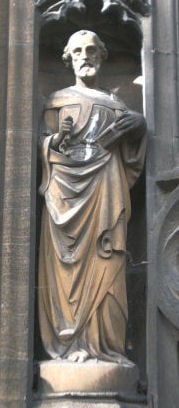
In Roman Catholic religious doctrine and tradition, Saint Peter is the patron saint of the following categories
| Workers | ||
|---|---|---|
|
|
|
| Called for aid in | ||
|
| |
| Institutions | ||
|
|
|
| Locations | ||
|
| |
See also
- Disciple
- Saint Peter's Basilica
- Twelve Apostles
- Papacy
Notes
- ↑ Gospel of Thomas 13 www.misericordia.edu Retrieved May 10, 2008.
- ↑ Gospel of Thomas 114 www.misericordia.edu Retrieved May 10, 2008.
- ↑ Apocalypse of Peter www.earlychristianwritings.com Retrieved May 10, 2008.
- ↑ Gospel of Mary 9:4 www.gnosis.org Retrieved May 10, 2008.
- ↑ Gospel of Mary 9:6, www.gnosis.org Retrieved May 10, 2008.
- ↑ Gospel of Peter 14:3 www.cygnus-study.com Retrieved May 10, 2008.
- ↑ Petronilla www.newadvent.org Retrieved May 10, 2008.
- ↑ Finegan, The Archeology of the New Testament. 368–370. A more popular account of this tomb. www.aloha.net Retrieved May 10, 2008.
ReferencesISBN links support NWE through referral fees
- Brown, Raymond Edward, Karl P. Donfried, and John Henry Paul Reumann. Peter in the New Testament; A Collaborative Assessment by Protestant and Roman Catholic Scholars. Minneapolis: Augsburg Pub. House, 1973. ISBN 9780806614014
- Card, Michael. A Fragile Stone: The Emotional Life of Simon Peter. Downers Grove, Ill: InterVarsity Press, 2003. ISBN 9780851117850
- Goulder, M. D. St. Paul Versus St. Peter: A Tale of Two Missions. Louisville, KY: Westminster/John Knox Press, 1995. ISBN 9780664255619
- Grant, Michael. Saint Peter: A Biography. New York: Scribner, 1995. ISBN 9780684193540
- O'Connor, Daniel William. Peter in Rome: The Literary, Liturgical, and Archeological Evidence. New York: Columbia University Press, 1969. ISBN 9780231029667
- Perkins, Pheme. Peter: Apostle for the Whole Church. Studies on personalities of the New Testament. Columbia, S.C.: University of South Carolina Press, 1994. ISBN 9780872499744
- Spell, David. Peter and Paul in Acts. Eugene, OR: Wipf & Stock, 2006. ISBN 9781597527842
External links
All links retrieved December 22, 2022.
- Jewish Encyclopedia: Simon Cephas www.jewishencyclopedia.com
- Catholic Encyclopedia: St Peter, Prince of the Apostles www.newadvent.org
- Catholic Encyclopedia: Epistles of St Peter
| Preceded by: none |
Bishop of Antioch 37–53 |
Succeeded by: Evodius |
| Preceded by: none |
Pope (according to Roman Catholic dogma) 30–64 or 67 |
Succeeded by: Linus |
| |||||
Credits
New World Encyclopedia writers and editors rewrote and completed the Wikipedia article in accordance with New World Encyclopedia standards. This article abides by terms of the Creative Commons CC-by-sa 3.0 License (CC-by-sa), which may be used and disseminated with proper attribution. Credit is due under the terms of this license that can reference both the New World Encyclopedia contributors and the selfless volunteer contributors of the Wikimedia Foundation. To cite this article click here for a list of acceptable citing formats.The history of earlier contributions by wikipedians is accessible to researchers here:
The history of this article since it was imported to New World Encyclopedia:
Note: Some restrictions may apply to use of individual images which are separately licensed.
